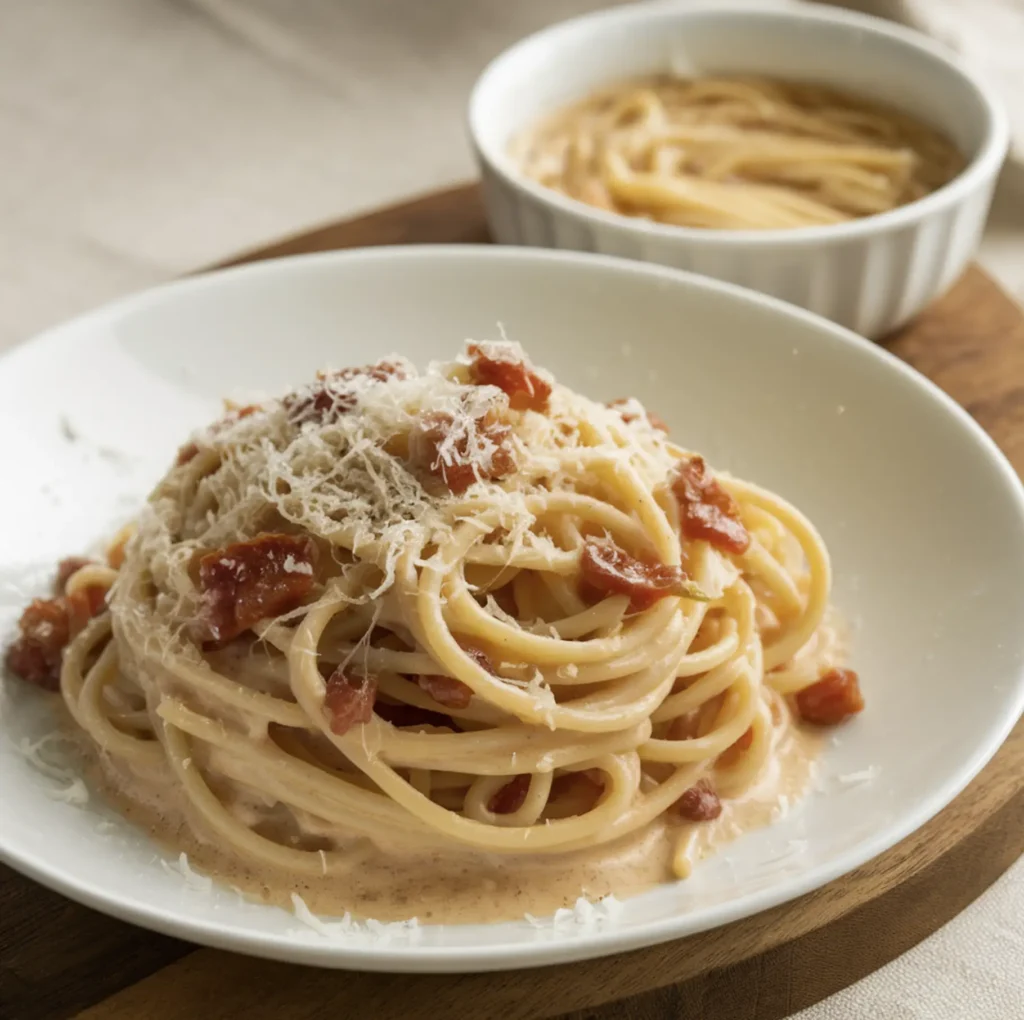Spaghetti Carbonara is one of the most beloved dishes in Italian cuisine, famous for its rich, creamy texture and savory, smoky flavors. It has become a staple in many kitchens worldwide, yet, despite its simplicity, it is a dish that requires precision to achieve perfection. What exactly is Spaghetti Carbonara? How can you make it like a true Italian chef? This article will answer all of your questions, taking you through the ingredients, the history, and the best way to prepare it. In addition, we’ll provide some creative variations, answer frequently asked questions, and offer tips for mastering this classic dish.
What Is Spaghetti Carbonara? A Brief History
Spaghetti Carbonara is a classic Roman pasta dish typically made with eggs, cheese, guanciale (cured pork cheek), and black pepper. Notably, this creamy sauce does not contain any cream at all! The silky texture comes from the emulsion of the pasta’s hot water, the eggs, and the grated cheese.
The Origins of Carbonara
There is some debate about the origins of Spaghetti Carbonara, and as a result, several theories have emerged. One popular theory suggests that Carbonara was created by Italian coal miners (carbonari) in the Lazio region, who would combine their simple rations of eggs, pasta, and cured meat. On the other hand, another theory suggests that American soldiers introduced the dish to Italy during World War II, bringing with them bacon and powdered eggs. While the true origin remains unclear, there is no doubt that Spaghetti Carbonara has become an iconic Italian dish that’s loved by many.
Traditional Spaghetti Carbonara Ingredients
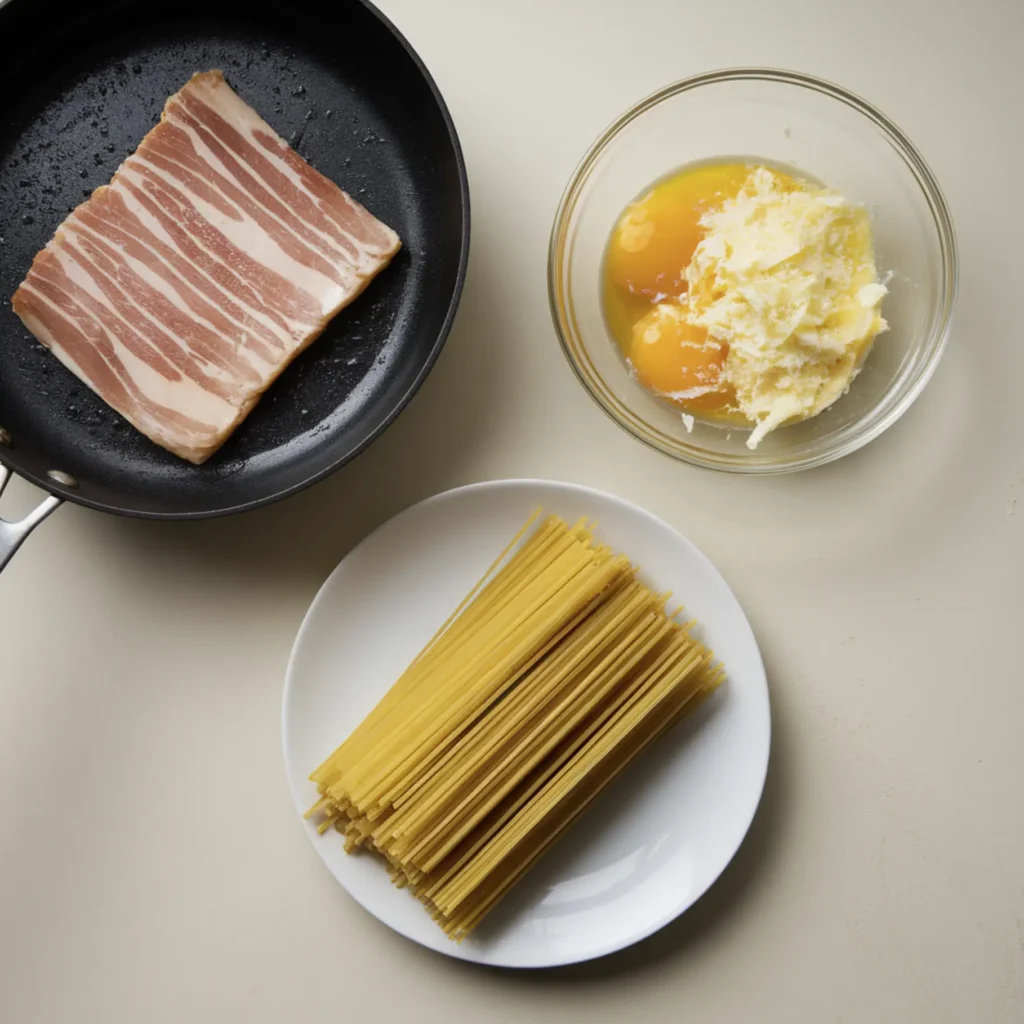
Spaghetti Carbonara is a dish that requires few ingredients but careful attention to detail. However, once you master the process, making this dish becomes second nature. In fact, it’s the simplicity of the dish that makes it so special. To prepare the most authentic Spaghetti Carbonara, you’ll need the following ingredients:
- Spaghetti: This is the traditional pasta for Carbonara, though other types such as fettuccine or rigatoni can be used as well.
- Guanciale: This is an Italian cured meat made from the cheek or jowl of the pig. It’s much fattier than pancetta and gives Carbonara its signature richness.
- Pecorino Romano: A sharp, salty sheep’s milk cheese that is integral to the flavor of the dish.
- Eggs: You’ll need large eggs, typically only the yolks, to create the sauce. It’s essential to avoid scrambling the eggs, so a proper technique is required.
- Black Pepper: Freshly cracked black pepper adds the final touch of heat and spice to the dish.
- Pasta Water: The starchy water that you reserve after cooking the pasta is key to creating the creamy sauce without the use of cream.
With these five simple ingredients, you can create an authentic and delicious plate of Spaghetti Carbonara.
Guanciale vs. Pancetta: The Essential Ingredient Debate
When it comes to Spaghetti Carbonara, people often debate whether to use guanciale or pancetta. Both are Italian cured meats, but they differ in taste and texture, which significantly affects the final flavor of the dish.
Guanciale: The Traditional Choice Guanciale, made from the cheek or jowl of the pig, has a higher fat content and a more delicate, melt-in-your-mouth texture. It also imparts a rich, savory flavor that is essential to authentic Carbonara. The fat from guanciale renders beautifully, coating the pasta with its luscious oils and adding a distinct depth of flavor.
Pancetta: A Possible Substitute Pancetta, made from the belly of the pig, is often easier to find outside of Italy. While it has a similar flavor to bacon, it’s less smoky. Pancetta can still make a good Carbonara, but it won’t achieve the same level of richness that guanciale brings. Not only that, pancetta has a firmer texture and less fat, which means it won’t render as much fat into the pasta, potentially affecting the sauce’s creaminess.
Which is better for your Carbonara? Although guanciale is the traditional choice, both meats can work in a pinch. However, for authentic Carbonara, guanciale is recommended for its superior flavor and texture.
The Science Behind Carbonara: Why the Eggs Don’t Scramble
The process of making Spaghetti Carbonara involves a delicate balance between the heat of the pasta, the egg yolks, and the cheese. Understanding the science behind the dish can help ensure the eggs do not scramble and that the sauce turns out perfectly creamy.
How the Eggs Work Egg yolks are the key to the creamy sauce in Carbonara. When mixed with the grated cheese and then added to the hot pasta, the heat from the pasta helps cook the eggs, but not too much. The key is to avoid direct contact between the eggs and high heat, as this can cause them to scramble. In addition, the residual heat from the pasta and the guanciale fat helps to gently cook the eggs, creating a silky texture.
Why Timing Is Crucial Timing is everything in Carbonara. If the egg mixture is added to the pasta while it is still too hot, the eggs will scramble, and you’ll lose that creamy texture. On the other hand, if the pasta is too cool, the sauce won’t form properly. Consequently, it’s important to toss the pasta immediately with the egg mixture to ensure everything combines perfectly.
The Role of Pasta Water As mentioned earlier, pasta water is the secret weapon to perfect Carbonara. The starch in the water helps to create an emulsion, making the sauce thicker and preventing the eggs from scrambling. This is why you should always add the pasta water gradually and continue stirring until the sauce reaches the perfect consistency.
Step-by-Step Guide to Making Spaghetti Carbonara
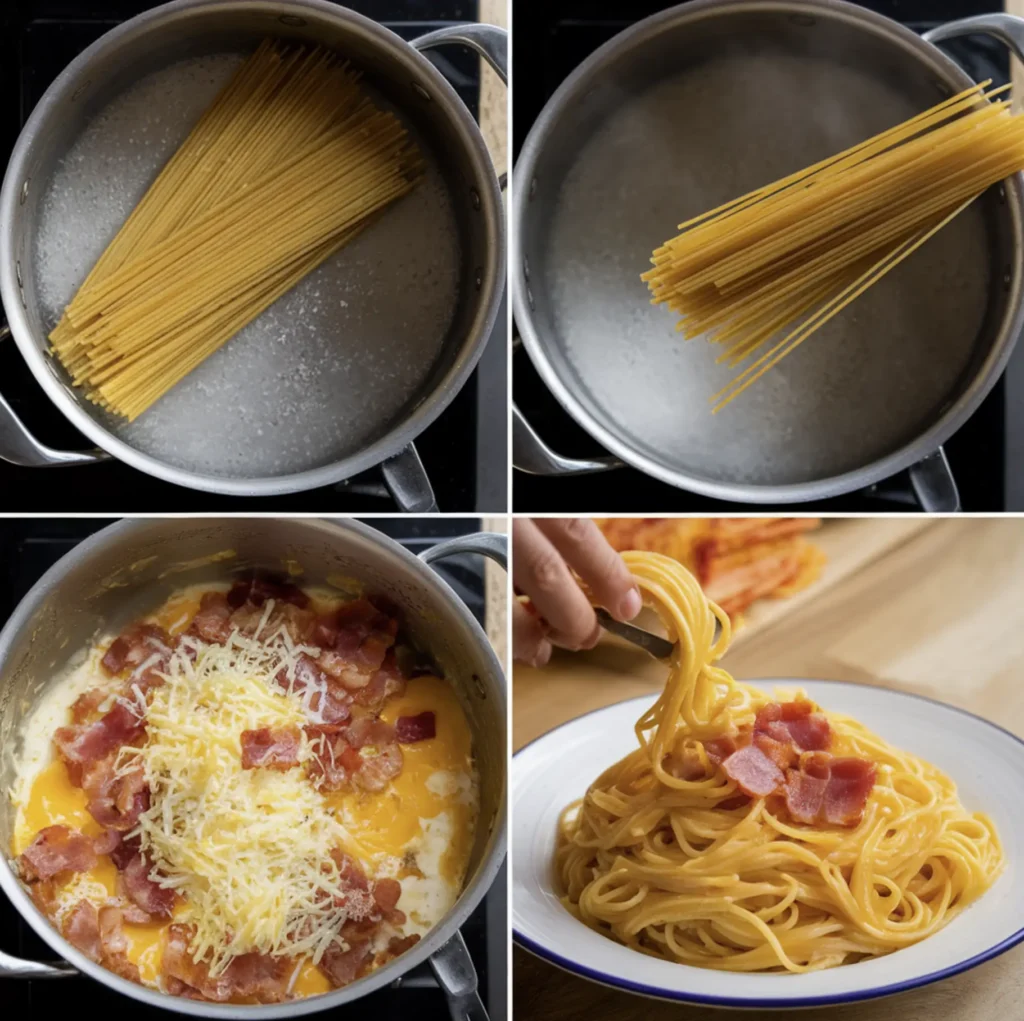
Although the ingredients are simple, the technique for preparing Spaghetti Carbonara requires precision. However, once you master the process, making this dish becomes second nature. Below is a step-by-step guide on how to make Spaghetti Carbonara:
Step 1: Prepare Your Ingredients
Before you begin, it’s important to have everything ready. Guanciale should be sliced or diced into small pieces. Pecorino Romano cheese should be finely grated, and egg yolks should be separated from the whites (you’ll need about two yolks per person). In addition, make sure to reserve some pasta water before draining the spaghetti. This will be crucial for the next step.
Step 2: Cook the Pasta
Fill a large pot with salted water and bring it to a boil. Add the spaghetti and cook it until al dente, which typically takes around 8-10 minutes. Make sure to reserve about 1 cup of pasta water before draining. This will be crucial for the next step.
Step 3: Cook the Guanciale
While the pasta is cooking, heat a pan over medium heat and add the diced guanciale. Sauté the guanciale until it becomes golden brown and crispy, releasing its flavorful fat. This should take about 5-7 minutes. The fat from the guanciale will add a rich, savory flavor to the dish.
Step 4: Make the Egg and Cheese Mixture
In a bowl, whisk the egg yolks and the grated Pecorino Romano cheese together. Add freshly cracked black pepper to taste and mix everything well. This mixture is key to the creamy texture of the dish, so make sure it’s smooth and well combined.
Step 5: Combine the Pasta and Guanciale
Once you cook and drain the pasta, add it immediately to the pan with the guanciale. Toss the pasta to coat it evenly with the guanciale’s fat, which will impart a delicious, smoky flavor to the pasta.
Step 6: Create the Carbonara Sauce
At this point, you should remove the pan from the heat to prevent scrambling the eggs. Next, quickly add the egg and cheese mixture to the pasta, tossing it vigorously to ensure it coats the spaghetti evenly. The heat from the pasta will cook the egg mixture, creating the creamy sauce. Add reserved pasta water a little at a time to achieve the desired consistency. The result should be a smooth, silky sauce that clings to the pasta.
Step 7: Serve and Enjoy
Once the pasta is coated in the creamy sauce, plate it up and top with extra grated Pecorino Romano cheese and freshly ground black pepper. Serve immediately, and enjoy your authentic Spaghetti Carbonara!
The Role of Pasta Water in Carbonara: Why It’s Essential
One of the secrets to making the perfect Spaghetti Carbonara lies in the use of pasta water. This starchy water, reserved after cooking the pasta, is a vital ingredient for creating the creamy, smooth sauce that makes Carbonara so special.
Why is pasta water so important? When the pasta is cooked, it releases starch into the water. This starch helps bind the egg mixture with the pasta, resulting in a silky sauce rather than a runny or scrambled egg dish. The warmth of the pasta water helps emulsify the fat from the guanciale and the egg yolks, creating the perfect balance of creaminess without any cream.
How to use pasta water properly? To achieve the best consistency, add the pasta water gradually to the egg and cheese mixture. This will allow you to control the thickness of the sauce and prevent it from becoming too watery or too thick. A small ladle or cup is ideal for transferring the water, and you only need to add a few tablespoons at a time until the desired texture is reached. In short, the pasta water is what transforms a simple egg mixture into the luxurious, creamy sauce that defines Spaghetti Carbonara.
Creative Variations of Spaghetti Carbonara
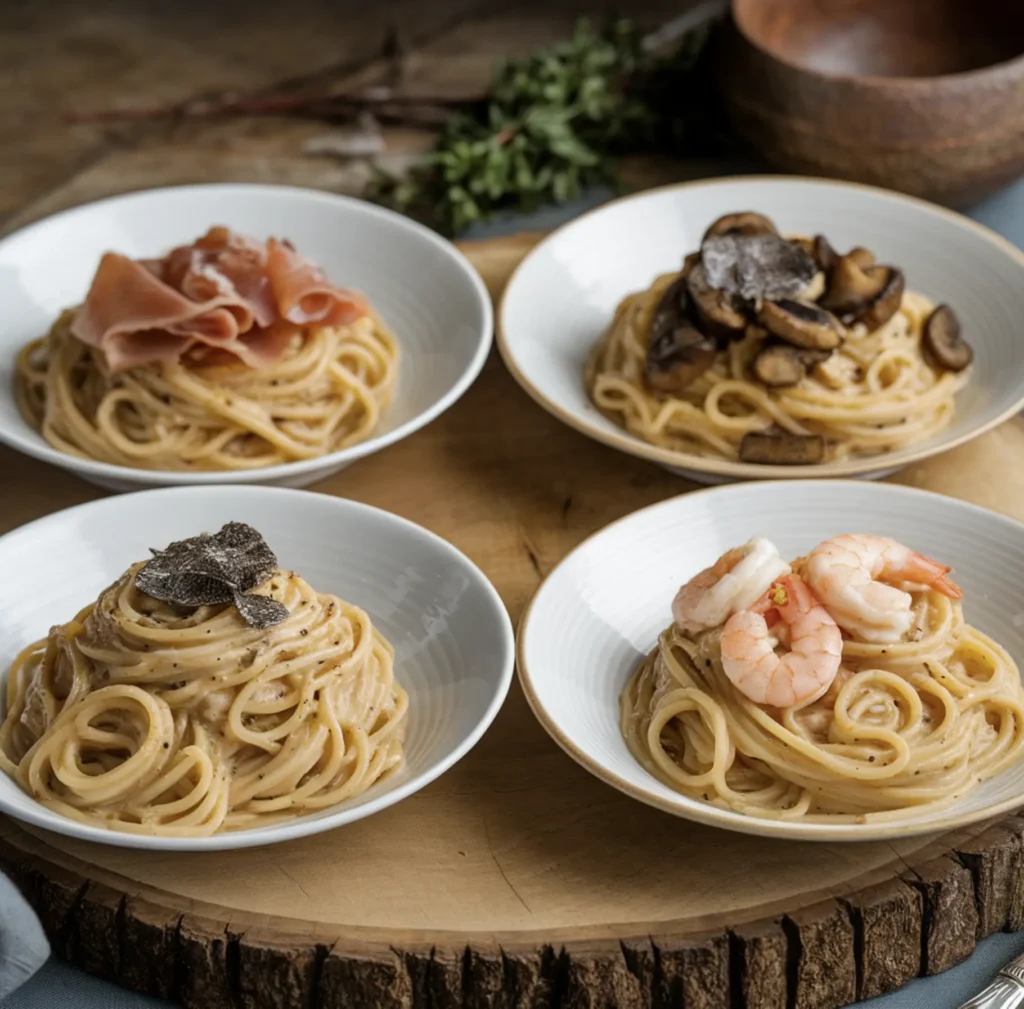
Although traditional Spaghetti Carbonara is perfect on its own, there are plenty of ways to add a twist to this classic dish. Here are some creative variations you might want to try:
1. Vegetarian Carbonara
For those who prefer a vegetarian version, you can substitute the guanciale with sautéed mushrooms or smoked tofu. Mushrooms provide an earthy flavor that pairs well with the creamy sauce. In addition, smoked tofu gives a rich, meaty texture without using animal products. This version is not only delicious but also perfect for those on a meat-free diet.
2. Seafood Carbonara
If you’re a fan of seafood, try adding shrimp, scallops, or crab to your Carbonara. The delicate sweetness of seafood complements the rich, creamy sauce. Moreover, seafood Carbonara brings a fresh, elegant twist to the traditional recipe.
3. Spicy Carbonara
For those who like a bit of heat, add a pinch of red pepper flakes or a drizzle of chili oil to your Carbonara. The heat balances the richness of the dish and adds a delightful kick. In fact, the spicy version is particularly popular in some regions of Italy where spicy food is a favorite.
4. Truffle Carbonara
For a more luxurious version, consider adding truffle oil or truffle salt to your Carbonara. The earthy, aromatic flavor of truffles pairs beautifully with the creamy sauce, turning this dish into something truly special. This variation is perfect for a celebratory meal or a dinner party.
How to Customize Spaghetti Carbonara for Special Diets
Whether you’re accommodating dietary restrictions or looking to try something new, you can easily customize Spaghetti Carbonara. There are various ways to modify the recipe to suit specific diets, without compromising too much on flavor.
1. Gluten-Free Carbonara For those who are gluten intolerant, you can use gluten-free pasta instead of traditional spaghetti. Fortunately, many gluten-free pasta varieties now have a great texture and flavor that can replicate the bite of traditional pasta. Just be sure to cook it al dente, as gluten-free pasta can sometimes become mushy if overcooked. Moreover, many gluten-free pasta options contain rice or corn flour, which works beautifully with the creamy sauce.
2. Dairy-Free Carbonara For a dairy-free version, you can use nutritional yeast instead of Pecorino Romano cheese. Nutritional yeast provides a cheesy, nutty flavor without dairy, and it can give the Carbonara a similar richness. Alternatively, vegan cheese options are available that replicate the creaminess of traditional cheese. In addition, consider using coconut milk or cashew cream in place of the egg yolks to achieve a creamy texture without the use of dairy.
3. Low-Carb or Keto Carbonara For those following a low-carb or keto diet, you can substitute traditional pasta with zucchini noodles or shirataki noodles. These alternatives are low in carbs but will still allow you to enjoy the creamy sauce and smoky guanciale.
By making a few substitutions, Spaghetti Carbonara can fit a variety of dietary preferences, making it a versatile dish for many people.
FAQs
What’s the Difference Between Pancetta and Guanciale in Carbonara?
Guanciale is a type of Italian cured meat that has a richer, more intense flavor, making it the preferred choice for traditional Carbonara. Its unique texture and savory taste contribute to a deeper, more complex flavor profile. On the other hand, pancetta has a milder flavor and a firmer texture, which makes it a more subtle choice for the dish.
How Do I Make Spaghetti Carbonara Without Scrambling the Eggs?
The key to preventing scrambled eggs is to remove the pan from the heat before adding the egg mixture. Additionally, toss the pasta quickly and continuously to ensure that the eggs don’t cook too quickly. Adding pasta water gradually helps create a smooth sauce without scrambling the eggs. In short, it’s important to combine the ingredients while the pasta is still hot but not too hot, so the eggs can cook gently and emulsify into the sauce.
Can I Make Carbonara Without Parmesan Cheese?
Yes, you can use Pecorino Romano instead of Parmesan, as it is the traditional cheese used in Carbonara. Pecorino has a sharper, saltier taste compared to Parmesan, which adds a distinctive flavor to the dish. However, if you prefer a milder flavor, you can opt for Parmesan instead. In fact, some people mix both cheeses for a balanced, flavorful sauce.
How to Store and Reheat Spaghetti Carbonara?
Carbonara is best served fresh, but if you need to store leftovers, place them in an airtight container and refrigerate for up to 2 days. When reheating, add a splash of reserved pasta water and gently reheat on the stove, stirring constantly to restore the creamy texture. Additionally, you can reheat it in the microwave, but be sure to add a little bit of water to prevent the sauce from becoming too thick.
Is Spaghetti Carbonara Safe for Pregnant Women?
Pregnant women should avoid raw or undercooked eggs due to the risk of salmonella. To make Carbonara safe, use pasteurized eggs or carefully cook the egg mixture to ensure it’s fully cooked. As a result, you can enjoy Carbonara without any safety concerns, as pasteurized eggs carry a lower risk of foodborne illnesses.
Get the Classic Spaghetti Carbonara Recipe Now!
Ready to make the ultimate Italian dish? Dive into our step-by-step guide to making Classic Spaghetti Carbonara that’s as authentic as it gets! 🍝
From selecting the right ingredients to perfecting the sauce, we’ve got everything you need to create this timeless favorite. Start cooking the perfect Carbonara today, and bring a taste of Italy to your kitchen!
Conclusion: Mastering Spaghetti Carbonara
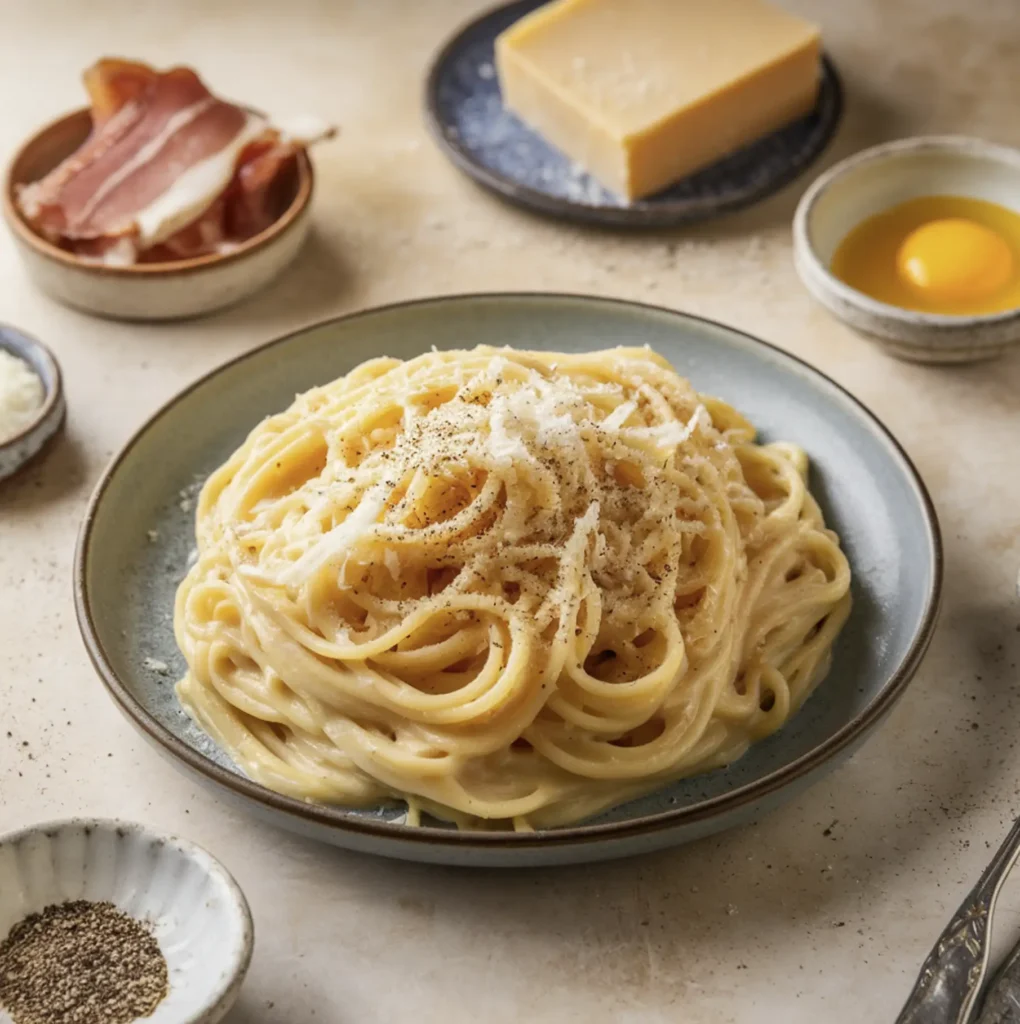
In conclusion, you can easily make Spaghetti Carbonara at home, and it offers a simple yet incredibly flavorful dish. Not only that, but with just a few ingredients and a bit of technique, you can create an authentic, creamy Carbonara that rivals any restaurant version. By experimenting with variations or sticking to the classic recipe, you can find the perfect version to suit your tastes. So, gather your ingredients, follow the steps, and enjoy a delicious, comforting plate of Spaghetti Carbonara!
For more pasta recipes, you might enjoy our guide to making delicious Seafood Pasta or learn more about the flavors in Drunken Noodles.
For more authentic Italian recipes, check out these helpful resources: An Italian in My Kitchen and RecipeTin Eats Carbonara.
